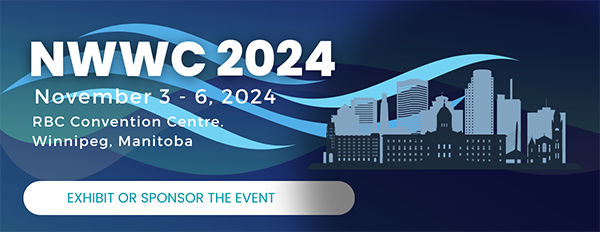 |
||||||||||||||
| Subscribe | Past Issues | www.cwwa.ca | Water Source Magazine | ||||||||||||||
|
CWWA News
Every now and again, I use this column to vent some frustrations. Those rants are usually the most popular, bringing the most reaction from readers. Several months back I expressed my disappointment with the Canada Infrastructure Bank (CIB) – suggesting their 5-year review was a waste of time. But I’m willing to take back my words when I am (happily) proven wrong. The 2024 IWA World Water Congress & Exhibition (WWCE) will take place in Toronto, Canada, from 11-15 August 2024. It will be held in the first-class facilities of the Metro Toronto Convention Centre. This is one of the greatest global water events, and it is being hosted here in North America by your water associations – CWWA and CAWQ, with the support of WEF and AWWA. As hosts, we need to have a great presence as we welcome the world. The IWA WWCE 2024 therefore presents an opportunity like no other to profile your organization and showcase your technologies, solutions and expertise! NEW - we've added a pillar option, this affordable option still gets you access to this elite range of delegates from around the world at a more economical price. The Call for Presentations for the NWWC 2024 is closed, and our review committee has begun the work of selecting presentations and building the program. In the meantime we're excited to share our exhibitor and sponsorship packages. Exhibiting and sponsoring is a great way to support the event and gain access to our elite range of delegates. We've expanded our sponsorship packages to include more options at more price points. Federal Initiatives
The federal government tabled the 2024 budget on April 16. Most of the budget focused on economic measures to improve the economy, affordability, and housing availability. As part of the commitment to facilitate building new homes the government announced a new $6 billion Canada Housing Infrastructure Fund to help communities build the essential infrastructure needed to support more homes, and more vibrant, and livable neighbourhoods. On World Water Day, the Canadian Government announced over $800,000 in funding for projects to protect fresh water, under the Community Interaction Program of the St. Lawrence Action Plan 2011–2026. The program, co-administered with Quebec's environmental ministry, supports community efforts to conserve biodiversity and improve water quality in the St. Lawrence River The funding aligns with the 2023 budget's $650 million allocation for water bodies' monitoring and restoration, and the Canada–Quebec Agreement's contribution of over $8.7 million to 125 projects. Member News
NACWA has released a new resource Navigating the Current PFAS Landscape: Thoughts for the Clean Water Sector to Consider. This resource is intended to help clean water agencies navigate the current landscape of federal, and where relevant, state efforts on PFAS and outlines a variety of regulatory and legislative activity and how those actions may impact public clean water utilities.
Turning Tides
The Biosolids Community lost two champions this month. We’re saddened to share the deaths of Ewa Madey (Canadian Food Inspection Agency) and Aaron Law (OCWA). Both were members of the CWWA Biosolids Committee and generously shared their knowledge and expertise with the Committee and CWWA. Outside their professional work they were both kind, generous people and will be greatly missed. Provincial News
Alberta has introduced a digital system for managing approximately 25,000 water licences, urging holders of licences issued before November 2021 to transition to this online platform by the end of 2024. The shift aims to streamline reporting, facilitate drought management, and enhance service delivery. The Digital Regulatory Assurance System (DRAS) offers a secure, confidential means for submissions and tracking, without altering existing licence details. While new licences are already integrated, older licences, including those under the Water Act and related legislation, must migrate to DRAS, with the Water Use Reporting System (WURS) set to close by June 2024. Future updates will incorporate documents under the Environmental Protection and Enhancement Act and the Public Lands Act. Manitoba Government Taking Steps to Protect Waterways The Manitoba government is amending the Environment Act to better protect waterways, with a focus on immediate intervention in cases like sewage spills. Environment and Climate Change Minister Tracy Schmidt highlighted the need for quicker responses to water treatment issues and announced a $10 million commitment to aid Winnipeg's wastewater infrastructure improvements. The current Act's limitations delay rapid action due to the requirement of extensive investigations and court proceedings, and there is no mandate for notifying the public or affected communities about significant incidents. ES&E Magazine Alberta's 2024 budget boosts municipal water program funding to $482 million over three years, up $74 million from last year. Key allocations include $206.5 million for the Alberta Municipal Water/Wastewater Partnership, $237.7 million for Water for Life grants, and $37.7 million for the First Nations Water Tie-In Program. This investment addresses increased water demand due to a population rise of nearly 200,000 residents in 2023. Additionally, $19 million goes towards enhancing water availability, $75 million for flood and drought programs, and $8.7 million for wetland replacement. Infrastructure projects include the Nisku Booster Station ($21 million) and the completion of the Springbank off-stream reservoir ($163 million). Wastewater treatment upgrades in Strathcona County receive $50 million over three years. Snippings & Clippings
ES&E Magazine A Utah State University study, based on utility survey data, finds that 20% of water pipes in the U.S. and Canada need replacement, leading to 260,000 annual breaks. Led by research professor Steven Barfuss, the study involved 802 respondents and reveals $2.6 billion in yearly repair costs, with an average of $10,000 per break. While 70% of utilities have replacement programs, small ones face financial hurdles. The average age of failing water mains is 53 years. The study, the third of its kind from USU's Water Research Laboratory, tripled its sample size from 2018. It shows that 90% of water mains consist of PVC, ductile iron, cast iron, and asbestos cement, with PVC pipes having the lowest failure rates. Factors like pipe age and soil corrosivity influence break rates, with cast iron showing the highest failure rates. City of Toronto The City of Toronto has launched a reporting link for large building owners to annually report energy and water usage, aiding in environmental performance and cost reduction. Starting in 2024, buildings over 50,000 square feet must comply, with a July 2, 2024, deadline for 2023 data. The Energy Star Portfolio Manager will be used for both city and provincial reporting. The threshold lowers to 10,000 square feet in 2025. This initiative, part of the Net Zero Existing Buildings Strategy to achieve net zero emissions by 2040, includes informational webinars and support programs like Better Buildings Navigation & Support Services, Energy Retrofit Loan, Green Will Initiative, and Home Energy Loan Program (HELP). Details are available on the City's website. Water Canada The Environment and Climate Change Committee today approved a permanent, expanded Rain Ready Ottawa program to help residents manage rainfall on their properties, reduce the harmful impacts of stormwater runoff on small open watercourses and improve the health of Ottawa’s waterways. It is part of a suite of City programs that will help homeowners take action to make their properties more resilient to rainfall. Water Canada 3M announced that on Friday, March 29, the company’s previously announced settlement agreement with U.S. public water suppliers (PWS) received final approval from the U.S. District Court in Charleston, South Carolina. Statescoop House lawmakers this week introduced a bill that aims to strengthen cybersecurity protections for water and wastewater systems by creating a new, non-federal agency to update and manage the cybersecurity requirements for the critical infrastructure sector. USA Today With fluoride in so many dental products, some say adding it to drinking water is no longer necessary. But health experts worry that like vaccines, fluoridation may be a victim of its own success. The Hill The Biden administration on Wednesday set the first-ever national limits for toxic and pervasive ‘forever chemicals’ in drinking water. The administration’s action seeks to reduce the amount of chemicals belonging to a class known as PFAS in drinking water. NPR In Chicago, about 400,000 homes still get their tap water through lead service lines — pipes that connect individual homes to the main water line. And nearly 70% of young children are getting exposed to lead from their home tap water, according to recent estimates published in JAMA Pediatrics. The study also finds that Black and Hispanic neighborhoods are more likely to have lead exposure, but less likely to be tested for lead. Wisconsin Public Radio A new center at the University of Wisconsin-Madison will focus on studying PFAS and finding solutions to environmental contamination by the chemicals. The new center will be launched with federal funding announced last week. Scientists said they hope to be able to identify PFAS they currently can’t measure, and find ways to reverse or stop environmental damage caused by the substances sometimes called “forever chemicals.” San Antonio Current Sometimes you have to get gross to make a point. That's certainly the approach the San Antonio River Authority has taken to make residents aware that wipes advertised as "flushable" are anything but. Water Canada The Canada Infrastructure Bank (CIB) is loaning a combined up to $140 million to support five communities with water and wastewater infrastructure projects in Manitoba. This green infrastructure partnership will enable construction of new facilities which will deliver cleaner water and better wastewater treatment for approximately 78,000 housing units, while supporting the communities’ sustainable growth. Water Canada Fecal pollution in BC’s marine waters can lead to prolonged closures of shellfish harvesting areas and recreational beaches. These are important public health responses, but current surveillance methods can only detect the presence of fecal bacteria in the water, not the source — human or animal. ES&E Magazine A group of Texas farmers is suing a Maryland-based company, which also produces biosolids in Canada, over claims their farms were damaged by a biosolids-based fertilizer contaminated with PFAS. ES&E Magazine Alberta has targeted $482 million over three years for municipal water programs and infrastructure in its 2024 budget, with an emphasis on managing water for the future. The earmarked spending proposal is up nearly $74 million over last year’s budget. It includes a planned $206.5 million for the Alberta Municipal Water/Wastewater Partnership, $237.7 million in Water for Life grants, and $37.7 million in funding for the First Nations Water Tie-In Program. ES&E Magazine Following years of calls to modernize the Canadian Iron Ring ceremony for graduating engineers, which has been criticized for being outdated and non-inclusive, the ceremony’s governing body has now decided to keep the “best elements” of the traditional ritual and “embed them in a modernized ceremony.” |
||||||||||||||








